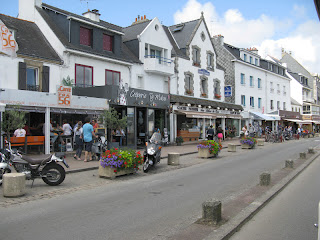At CARNAC, thousands of ancient granite rocks were arranged in mysterious lines and patterns by Megalithic tribes as early as 4,000 BC. Their original purpose remains obscure: the significance was probably religious, but the precise patterns also suggest an early astronomical calendar. Celts, Romans and Christians have since adapted them to their own beliefs.
Megaliths: There are many different formations of megaliths, all with a particular purpose. Words from the Breton language, such as men (stone), dole (table), and hir (long), are still used to describe them.
Menhirs, the most common megaliths, are upright stones, standing alone or arranged in lines. Those in circles are known as cromlechs.
The Carnac stones are an exceptionally dense collection of megalithic sites. The more than 3,000 prehistoric standing stones were hewn from local rock and are the largest such collection in the world.
Although the stones date from 4500 BC, modern myths were formed which resulted from 1st century AD Roman and later Christian occupations, such as Saint Cornelius – a Christian myth associated with the stones held that they were pagan soldiers in pursuit of Pope Cornelius when he turned them to stone. Brittany has its own local versions of the Arthurian cycle. Local tradition claims that the reason they stand in such perfectly straight lines is that they are a Roman legion turned to stone by Merlin.
Dolmen, two upright stones roofed by a third, were used as a burial chamber.
A tumulus is a dolmen covered with stones and soil to form a burial mound.
We took a little train ride through Carnac and realized that people come to Carnac mainly for the megaliths, but stay on because it's a great seaside resort.
ROSCOFF
We slept in Roscoff, once a Corsairs' haunt, now thriving as a Channel port and seaside resort. Signs of its wealthy seafaring past can be found in the old port. Here the granite façades of the 16th- and 17th-century shipowners' mansions, and the weather-beaten caravels and cannon decorating the 16th-century Eglise Notre-Dame-de-Kroaz-Baz, testify to the days when the privateers of Roscoff were as notorious as those of St-Malo.
The famous French onion sellers (Johnnies) first crossed the Channel in 1828, selling their braided onions door to door as far as Scotland. The Maison des Johnnies tells their colourful history.
This is definitely a sea port, with a wide assortment of seafood to choose from.
We both started with the crab appetizer. A lot of work for very little at the end, despite the size of the crab. Frankly, it made us work up an appetite!

My main course was scallops on a tangy salad bed.
Karl had scallops on a skewer.
I told you that we had worked up an appetite... Karl somehow managed to order a 2nd main course, which was chicken. Maybe he was trying to eat from all the food groups: seafood and meat...
This was the view from our hotel room. We had given up the cooing of the pigeons for the squawking of the seagulls. The air was pure and fresh and invigorating! Although we didn't have a view of the ocean, we could hear the waves breaking on shore.







































No comments:
Post a Comment